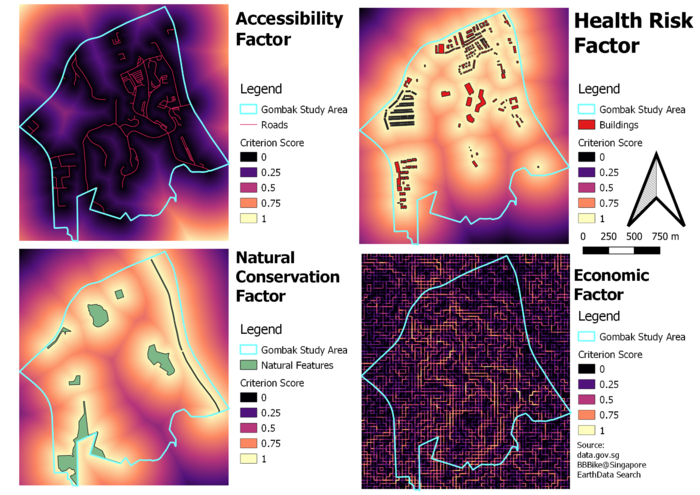SMT201 AY2019-20T1 EX2 Lim Qiu Hui Candy
Contents
Overall Map Views
Roads in Gombak
The map titled Roads shows the service and track roads in Gombak, used in transporting building materials for our Centre. It is notable that there is a high concentration of roads in the northern part of Gombak. Without considering other factors, it is instinctive for us to infer that perhaps the selected site can be placed in the north, where there are more roads and is more accessible.
Buildings in Gombak
The map titled Buildings shows the buildings in Gombak. It is notable that there are barely any buildings in the southern part of Gombak. Without considering other factors, it is instinctive for us to infer that the selected site can be placed in the south, where there are less buildings and prevents diseases from spreading to the nearby population.
Natural Features in Gombak
The map titled Natural Features shows the natural features in Gombak, like parks, water bodies and forested land. It is notable that there are barely any natural features in the central to southern part of Gombak. Without considering other factors, it is instinctive for us to infer that the selected site can be placed anywhere from central to south Gombak, where there are fewer natural features and prevents the construction from affecting the nature.
Elevation of Gombak
The map titled Elevation shows the elevation of land in Gombak. It is notable that the highest elevation is of 145m in central Gombak, and based on further research, that location is where Bukit Gombak Hill is located at. Hence, we can infer that the selected site should be placed away from the vicinity of Bukit Gombak Hill for natural conservation purposes and any construction on the steep land nearby will incur high costs.
Insights
It is hard to conclude at a glance where our selected site should be, without considering the 4 maps together as a whole and with the help of further GIS analysis. Hence, we convert these vector datasets into raster data for us to proceed with our modelling for the land suitability analysis.
Overall Proximity Map Views
In general, all the scales for the proximity in metres are set at a minimum of 0 to a maximum of 300 metres for a standardized and fair comparison throughout the three maps. The colours across the maps are standardized and the map layers are zoomed to its native resolution (100%) as well, for an easier comparison across all maps. A POI_CODE of 1 was assigned to the attributes tables of layers that are used for analysis, which are the raster layers for Roads, Buildings and Natural Features after conversion from its vector layer form.
Proximity to Roads in Gombak
The Proximity to Roads map shows the raster distance of locations on the map, within Gombak, to the roads. As the distance from the roads increase, the colours displayed to represent proximity gets lighter as well. From the QGIS modelling, the legend of this layer indicates that the furthest distance from the roads is 772.50 metres (rounded off to 2 decimal places).
Proximity to Buildings in Gombak
The Proximity to Buildings map shows the raster distance of locations on the map, within Gombak, to the buildings. As the distance from the buildings increase, the colours displayed to represent proximity gets lighter as well. From the QGIS modelling, the legend of this layer indicates that the furthest distance from the buildings is 826.62 metres (rounded off to 2 decimal places).
Proximity to Natural Features in Gombak
The Proximity to Natural Features map shows the raster distance of locations on the map, within Gombak, to the natural features. As the distance from the natural features increase, the colours displayed to represent proximity gets lighter as well. From the QGIS modelling, the legend of this layer indicates that the furthest distance from the natural features is 863.67 metres (rounded off to 2 decimal places).
Slope of Gombak
The Slope map shows the angle of inclination to the horizontal land in degrees. As the slope degree increases and the slope gets steeper, the colour lightens. The legend of Slope layer shows that the minimum and maximum values of the slope values are 0 and 70.8 degrees respectively, as I adjusted the land area to by 5m x 5m instead.
Overall Criterion Score Map Views
The maps in this section are based on a standardized criterion score of 0 to 1. The maps are derived by converting the scales of each proximity map using the Min-Max criteria standardisation technique. From here, we can then evaluate each of the proximities to the relevant deciding factor for the construction of the Centre.






